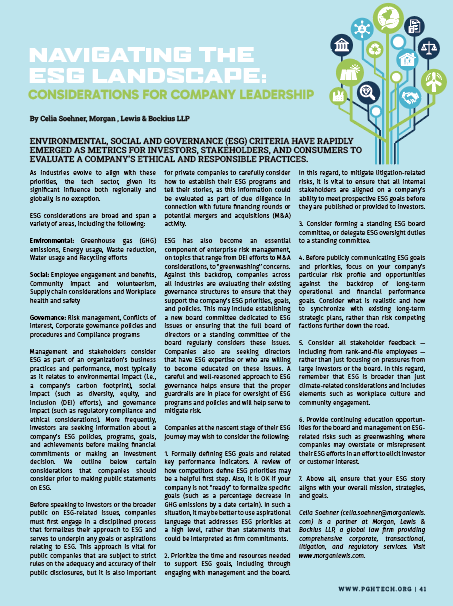MindShare: Navigating the ESG Landscape
By Celia Soehner, Morgan, Lewis & Bockius LLP
 Environmental, social and governance (ESG) criteria have rapidly emerged as metrics for investors, stakeholders, and consumers to evaluate a company’s ethical and responsible practices.
Environmental, social and governance (ESG) criteria have rapidly emerged as metrics for investors, stakeholders, and consumers to evaluate a company’s ethical and responsible practices.
As industries evolve to align with these priorities, the tech sector, given its significant influence both regionally and globally, is no exception.
ESG considerations are broad and span a variety of areas, including the following:
Environmental: Greenhouse gas (GHG) emissions, Energy usage, Waste reduction, Water usage and Recycling efforts
Social: Employee engagement and benefits, Community impact and volunteerism, Supply chain considerations and Workplace health and safety
Governance: Risk management, Conflicts of interest, Corporate governance policies and procedures and Compliance programs
Management and stakeholders consider ESG as part of an organization’s business practices and performance, most typically as it relates to environmental impact (i.e., a company’s carbon footprint), social impact (such as diversity, equity, and inclusion (DEI) efforts), and governance impact (such as regulatory compliance and ethical considerations). More frequently, investors are seeking information about a company’s ESG policies, programs, goals, and achievements before making financial commitments or making an investment decision. We outline below certain considerations that companies should consider prior to making public statements on ESG.
Before speaking to investors or the broader public on ESG-related issues, companies must first engage in a disciplined process that formalizes their approach to ESG and serves to underpin any goals or aspirations relating to ESG. This approach is vital for public companies that are subject to strict rules on the adequacy and accuracy of their public disclosures, but it is also important for private companies to carefully consider how to establish their ESG programs and tell their stories, as this information could be evaluated as part of due diligence in connection with future financing rounds or potential mergers and acquisitions (M&A) activity.
ESG has also become an essential component of enterprise risk management, on topics that range from DEI efforts to M&A considerations, to “greenwashing” concerns. Against this backdrop, companies across all industries are evaluating their existing governance structures to ensure that they support the company’s ESG priorities, goals, and policies. This may include establishing a new board committee dedicated to ESG issues or ensuring that the full board of directors or a standing committee of the board regularly considers these issues. Companies also are seeking directors that have ESG expertise or who are willing to become educated on these issues. A careful and well-reasoned approach to ESG governance helps ensure that the proper guardrails are in place for oversight of ESG programs and policies and will help serve to mitigate risk.
Companies at the nascent stage of their ESG journey may wish to consider the following:
1. Formally defining ESG goals and related key performance indicators. A review of how competitors define ESG priorities may be a helpful first step. Also, it is OK if your company is not “ready” to formalize specific goals (such as a percentage decrease in GHG emissions by a date certain). In such a situation, it may be better to use aspirational language that addresses ESG priorities at a high level, rather than statements that could be interpreted as firm commitments.
2. Prioritize the time and resources needed to support ESG goals, including through engaging with management and the board. In this regard, to mitigate litigation-related risks, it is vital to ensure that all internal stakeholders are aligned on a company’s ability to meet prospective ESG goals before they are published or provided to investors.
3. Consider forming a standing ESG board committee, or delegate ESG oversight duties to a standing committee.
4. Before publicly communicating ESG goals and priorities, focus on your company’s particular risk profile and opportunities against the backdrop of long-term operational and financial performance goals. Consider what is realistic and how to synchronize with existing long-term strategic plans, rather than risk competing factions further down the road.
5. Consider all stakeholder feedback —including from rank-and-file employees —rather than just focusing on pressures from large investors or the board. In this regard, remember that ESG is broader than just climate-related considerations and includes elements such as workplace culture and community engagement.
6. Provide continuing education opportun-ities for the board and management on ESG-related risks such as greenwashing, where companies may overstate or misrepresent their ESG efforts in an effort to elicit investor or customer interest.
7. Above all, ensure that your ESG story aligns with your overall mission, strategies, and goals.
Celia Soehner (celia.soehner@morganlewis.com) is a partner at Morgan, Lewis & Bockius LLP, a global law firm providing comprehensive corporate, transactional, litigation, and regulatory services. Visit www.morganlewis.com.